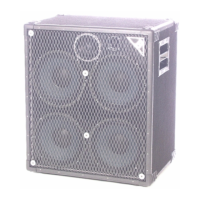Or send your speaker back to us, to insure that the job will be done right.
ailable with receptacles installed for use with common “Ultimate”
style tripod stands. The charge for this option is $30 per cab
Small modeling predicts a
6dB point of 31 Hz, below which response rolls off rapidly. In many real
world situations, with walls and floor nearby, perceived response will seem very flat to this point, and no
e desirable. In situations where equalization may be necessary (such as when
elevating the speaker on a stand with very wide ran
ge program material, or playing outdoors), 6 dB of
boost at 31 Hz will result in a theoretical near
perfect flat response. (Spea
geeks will recognize this as
order alignment,” a concept pioneered by A. N. Thiele, and put into production
The speaker is designed to withstand high power in this region, and should easily handle mo
CAUTION: Cone excursion increases rapidly below 30.87 Hz (Low B), and any low end boost below this
es power handling, and could damage the woofers.
Speakers capable of producing only
a limited bandwidth (frequency response) need to be used with a
second speaker, and can benefit from biamping. Full range system
s, such as the Acme Low B systems do
ten systems are designed with limited bass extension, an
greatly from the addition of a larger woofer. (You are probably aware of our B
cely in this application.) The Low B systems are full
range systems, however, and biamping
would only serve to restrict them. BI
The attenuators which control the output levels of the midrange and tweeter on the Low
calibrated on the back panels in
. Some customers have called in confusion, commenting
A typical amplifier will have level controls marked “1 through 10.” The higher the number, the louder the
sound. A level control calibrated in dB of attenuation seems different
zero attenuation can be considered
cally, both schemes result in highest output when turned to maximum clockwise position. The
operation of the two differently cal
ibrated level controls is, in practice, the same. It is only the markings
on the dial which are different. The attenuators on yo
ur Low B speaker operate just as any level controls.
They are simply marked, or calibrated, in the opposite fashion. Zero dB of
attenuation is synonymous
Depending on your circumstances, lint can collect on
the carpet covering your Acme speaker. It is easy to
remove it though, and to restore the unit to it’s original good looks. The
easiest way is with simple
cellophane tape. Just put the tape over the dirty area. When you remove the tape, the dirt/lint will
with it. If your speaker is covered with a large amount of lint, you can use wide cellophane packaging

